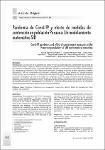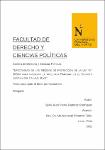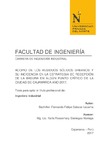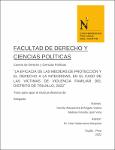Mostrar el registro sencillo del ítem
Covid-19 pandemic and effect of containment measures in the Peruvian population: A SIR mathematical modeling [Pandemia de Covid-19 y efecto de medidas de contención en población peruana: un modelamiento matemático SIR]
| dc.contributor.author | Espinola-Sánchez, Marcos | |
| dc.contributor.author | Racchumí-Vela, Augusto | |
| dc.contributor.author | Sanca-Valeriano, Silvia | |
| dc.contributor.author | Espinola-Sánchez, Sergio | |
| dc.contributor.author | Arango-Ochante, Pedro | |
| dc.contributor.author | Saldana-Díaz, Claudia | |
| dc.contributor.author | Segundo-Paredes, Jorge | |
| dc.contributor.author | Mejico-Caja, Melisa | |
| dc.date.accessioned | 2021-06-09T21:59:29Z | |
| dc.date.available | 2021-06-09T21:59:29Z | |
| dc.date.issued | 2020-08-08 | |
| dc.identifier.citation | Espinola, M. ...[et al]. (2020). Revista del Cuerpo Médico Hospital Nacional Almanzor Aguinaga Asenjo. Revista del Cuerpo Médico Hospital Nacional Almanzor Aguinaga Asenjo, 13(2), 110–115. https://doi.org/10.35434/rcmhnaaa.2020.132.656 | es_PE |
| dc.identifier.issn | 2225-5109 | |
| dc.identifier.uri | https://hdl.handle.net/11537/26772 | |
| dc.description.abstract | ABSTRACT Introduction: The evolution of the COVID-19 pandemic varies in each population; it has been complicating health systems worldwide. Objective: to analyze the evolution of the Covid-19 pandemic, estimating the effect of the containment measures practiced in Peru. Material and Method: The SIR epidemiological mathematical modeling was applied, estimating the COVID-19 evolution in our population. Data analysis was performed following the SIR mathematical model with defined ordinary differential equations to simulate epidemiological behavior; and it was executed in the RStudio programming language. Results: Containment measures decreased the propagation rate, reducing 30% of infected cases until the peak day of infection; however, it is still above the effective reproductive number to control the epidemic and it shows an erratic trend, the result of government actions being 61% in the practice of containment measures. Conclusions: Containment measures are necessary if strategies are considered to make their role effective in our population. | es_PE |
| dc.format | application/pdf | es_PE |
| dc.language.iso | spa | es_PE |
| dc.publisher | Cuerpo Médico Hospital Nacional Almanzor Aguinaga Asenjo | es_PE |
| dc.rights | info:eu-repo/semantics/openAccess | es_PE |
| dc.rights | Atribución-NoComercial-CompartirIgual 3.0 Estados Unidos de América | * |
| dc.rights.uri | https://creativecommons.org/licenses/by-nc-sa/3.0/us/ | * |
| dc.source | Universidad Privada del Norte | es_PE |
| dc.source | Repositorio Institucional - UPN | es_PE |
| dc.subject | Covid-19 | es_PE |
| dc.subject | Pandemia | es_PE |
| dc.subject | Reproducción | es_PE |
| dc.subject | Población | es_PE |
| dc.subject | Perú | es_PE |
| dc.title | Covid-19 pandemic and effect of containment measures in the Peruvian population: A SIR mathematical modeling [Pandemia de Covid-19 y efecto de medidas de contención en población peruana: un modelamiento matemático SIR] | es_PE |
| dc.type | info:eu-repo/semantics/article | es_PE |
| dc.publisher.country | PE | es_PE |
| dc.identifier.journal | Revista del Cuerpo Médico Hospital Nacional Almanzor Aguinaga Asenjo | es_PE |
| dc.subject.ocde | https://purl.org/pe-repo/ocde/ford#3.02.02 | es_PE |
| dc.description.sede | Breña | es_PE |
| dc.identifier.doi | https://doi.org/10.35434/rcmhnaaa.2020.132.656 |







